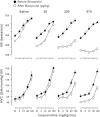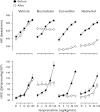Predicting in vivo cardiovascular properties of β-blockers from cellular assays: a quantitative comparison of cellular and cardiovascular pharmacological responses
- PMID: 21865315
- PMCID: PMC3371235
- DOI: 10.1096/fj.11-192435
Predicting in vivo cardiovascular properties of β-blockers from cellular assays: a quantitative comparison of cellular and cardiovascular pharmacological responses
Abstract
β-Adrenoceptor antagonists differ in their degree of partial agonism. In vitro assays have provided information on ligand affinity, selectivity, and intrinsic efficacy. However, the extent to which these properties are manifest in vivo is less clear. Conscious freely moving rats, instrumented for measurement of heart rate (β1; HR) and hindquarters vascular conductance (β2; HVC) were used to measure receptor selectivity and ligand efficacy in vivo. CGP 20712A caused a dose-dependent decrease in basal HR (P<0.05, ANOVA) at 5 doses between 6.7 and 670 μg/kg (i.v.) and shifted the dose-response curve for isoprenaline to higher agonist concentrations without altering HVC responses. In contrast, at doses of 67 μg/kg (i.v.) and above, ICI 118551 substantially reduced the HVC response to isoprenaline without affecting HR responses. ZD 7114, xamoterol, and bucindolol significantly increased basal HR (ΔHR: +122 ± 12, + 129 ± 11, and + 59 ± 11 beats/min, respectively; n=6), whereas other β-blockers caused significant reductions (all at 2 mg/kg i.v.). The agonist effects of xamoterol and ZD 7114 were equivalent to that of the highest dose of isoprenaline. Bucindolol, however, significantly antagonized the response to the highest doses isoprenaline. An excellent correlation was obtained between in vivo and in vitro measures of β1-adrenoceptor efficacy (R(2)=0.93; P<0.0001).
Figures








Similar articles
-
In vitro and in vivo characterization of intrinsic sympathomimetic activity in normal and heart failure rats.J Pharmacol Exp Ther. 1999 Apr;289(1):48-53. J Pharmacol Exp Ther. 1999. PMID: 10086986
-
Determination of beta-adrenoceptor subtype on rat isolated ventricular myocytes by use of highly selective beta-antagonists.Br J Pharmacol. 1995 Sep;116(1):1635-43. doi: 10.1111/j.1476-5381.1995.tb16384.x. Br J Pharmacol. 1995. PMID: 8564230 Free PMC article.
-
Comparative analysis of beta-1 adrenoceptor agonist and antagonist potency and selectivity of cicloprolol, xamoterol and pindolol.J Pharmacol Exp Ther. 1987 Sep;242(3):1025-34. J Pharmacol Exp Ther. 1987. PMID: 2888869
-
beta(2) and beta(3)-adrenoceptor inhibition of alpha(1)-adrenoceptor-stimulated Ca(2+) elevation in human cultured prostatic stromal cells.Eur J Pharmacol. 2007 Sep 10;570(1-3):18-26. doi: 10.1016/j.ejphar.2007.05.035. Epub 2007 Jun 5. Eur J Pharmacol. 2007. PMID: 17617401
-
Cardiovascular actions of xamoterol (ICI 118,587) in anaesthetized cats, rats, and guinea pigs.J Cardiovasc Pharmacol. 1986 Mar-Apr;8(2):314-23. doi: 10.1097/00005344-198603000-00014. J Cardiovasc Pharmacol. 1986. PMID: 2422470
Cited by
-
Synthesis and in vitro and in vivo characterization of highly β1-selective β-adrenoceptor partial agonists.J Med Chem. 2013 May 23;56(10):3852-65. doi: 10.1021/jm400348g. Epub 2013 May 10. J Med Chem. 2013. PMID: 23614528 Free PMC article.
-
Role of AKAP79/150 protein in β1-adrenergic receptor trafficking and signaling in mammalian cells.J Biol Chem. 2013 Nov 22;288(47):33797-33812. doi: 10.1074/jbc.M113.470559. Epub 2013 Oct 11. J Biol Chem. 2013. PMID: 24121510 Free PMC article.
-
Using Esterase Selectivity to Determine the In Vivo Duration of Systemic Availability and Abolish Systemic Side Effects of Topical β-Blockers.ACS Pharmacol Transl Sci. 2020 Jul 1;3(4):737-748. doi: 10.1021/acsptsci.0c00051. eCollection 2020 Aug 14. ACS Pharmacol Transl Sci. 2020. PMID: 32832874 Free PMC article.
-
Cardiovascular responses to retigabine in conscious rats--under normotensive and hypertensive conditions.Br J Pharmacol. 2013 Jul;169(6):1279-89. doi: 10.1111/bph.12203. Br J Pharmacol. 2013. PMID: 23581476 Free PMC article.
-
Monoclonal anti-β1-adrenergic receptor antibodies activate G protein signaling in the absence of β-arrestin recruitment.MAbs. 2014 Jan-Feb;6(1):246-61. doi: 10.4161/mabs.27226. MAbs. 2014. PMID: 24253107 Free PMC article.
References
-
- Hollenberg N. K. (2005)The role of β-blockers as a cornerstone of cardiovascular therapy. Am. J. Hypertens. 18, 165S–168S - PubMed
-
- Auerbach A. D., Goldman L. (2002) Beta-blockers and reduction of cardiac events in noncardiac surgery: scientific review. JAMA 287, 1435–1444 - PubMed
-
- Ellison K. E., Gandhi G. (2005) Optimising the use of beta-adrenoceptor antagonists in coronary artery disease. Drugs 65, 787–797 - PubMed
Publication types
MeSH terms
Substances
Grants and funding
LinkOut - more resources
Full Text Sources
Molecular Biology Databases

